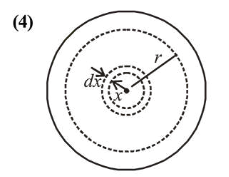The mass density of a planet of radius $R$ varies with the distance $r$ from its centre as $\rho(r)=\rho_{0}\left(1-\frac{r^{2}}{R^{2}}\right)$. Then the
gravitational field is maximum at:
Correct Option: , 4

Mass of small element of planet of radius $x$ and thickness $d x$.
$d m=\rho \times 4 \pi x^{2} d x=\rho_{0}\left(1-\frac{x^{2}}{R^{2}}\right) \times 4 \pi x^{2} d x$
Mass of the planet
$M=4 \pi \rho_{0} \int_{0}^{r}\left(x^{2}-\frac{x^{4}}{R^{2}}\right) d x$
$\Rightarrow M=4 \pi \rho_{0}\left|\frac{r^{3}}{3}-\frac{r^{5}}{5 R^{2}}\right|$
Gravitational field,
$E=\frac{G M}{r^{2}}=\frac{G}{r^{2}} \times 4 \pi \rho_{0}\left(\frac{r^{3}}{3}-\frac{r^{5}}{5 R^{2}}\right)$
$\Rightarrow E=4 \pi G \rho_{0}\left(\frac{r}{3}-\frac{r^{3}}{5 R^{2}}\right)$
$E$ is maximum when $\frac{d E}{d r}=0$
$\Rightarrow \frac{d E}{d r}=4 \pi G \rho_{0}\left(\frac{1}{3}-\frac{3 r^{2}}{5 R^{2}}\right)=0$
$\Rightarrow r=\frac{\sqrt{5}}{3} R$
